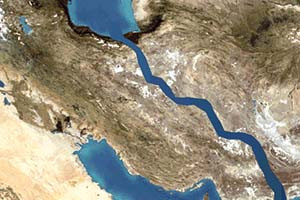
Since the time of the Romanov Czars, Russia has sought a link to warm water seas for its navy and its commerce. Today, Russian ships must pass through the Turkish Bosphorus straits, a very narrow waterway going through Istanbul from the Black Sea to the Sea of Marmara, and on via the Dardanelles, to the Aegean and Mediterranean Seas. Given the frozen relations between Moscow and Ankara today since the Turkish Air Force late last year deliberately downed a Russian jet inside Syrian airspace in violation of all norms of international law, passage of Russian vessels through the Bosphorus is a highly uncertain business, despite international treaties on freedom of passage.
As well, for Iranian ships or Chinese for that matter, to reach the Mediterranean ports of Europe, they now must pass via the Suez Canal owned by the Egyptian government. Despite the 1888 Convention of Constantinople, which grants the right of free access to all nations and ships in wartime or peace, the Egyptian government, as was clear during the Muslim Brotherhood US-backed coup of Mohammed Morsi, is also subject to dramatic political risk. The Iranian Canal also gives Russia and other states on the shortest way to the Indian Ocean bypassing the Turkish Straits and the Suez Canal in Egypt.
Tehran has now unveiled plans to build an artificial channel that will link the Caspian Sea and the Persian Gulf for the first time. It is scheduled to be complete in about a decade. It has huge economic, military and economic implications.
The Iranian ‘Suez Canal’
In every sense it will be a rival in economic and geopolitical terms to the Suez Canal. According to a report in Russia’s Sputnik News, the project was endorsed in 2012 by Iran’s former President Mahmoud Ahmadinejad while Western sanctions were still in place. The cost then was estimated by Khatam-al Anbiya, an engineering company owned by the Iranian Revolutionary Guard Corps (IRGC), at approximately $7 billion. At that time in a move to block the project, Washington imposed economic sanctions on companies that were involved in the project. Now for other geopolitical reasons, Washington has lifted many sanctions and Teheran is going ahead.
The Iranian Caspian Canal has a major security advantage. It runs strictly through Iranian space, space which is well-defended.
Two routes for the Iran ‘Suez Canal’ are considered. The shortest in the west would pass mountainous terrain while the longer would allow irrigation of vast desert regions of eastern Iran and avoid the narrow Strait of Hormuz between Oman and Iran.
The Eastern route Gulf of Oman to the south-east Caspian Sea has a total length of between 1465 – 1600 kilometers depending on internal routing. It would have the added advantage of allowing irrigation and development of agriculture in the dry east and central provinces of the country where shortage of rainfall has caused a massive drought in recent decades. The waterway would allow recharging the underground water resources.
The western route, while the shortest distance, has major drawbacks. The Western route of some 950 Km via partially navigable river beds would have to go through the Zagros mountains valleys for 600 Km. A major disadvantage of this route is the passage through the high Zagros and in Kurdistan and Hamedan provinces where it must climb to heights above 1800 meters.
Whichever route has been decided, and apparently reasons of national security have kept it discreet until now, several major advantages will grow out of the canal linking the Caspian to the Indian Ocean. First it will create the shortest marine link between the Persian Gulf and India on one side with the Eastern, Central and Northern Europe, on the other in direct competition with the politically unstable Egyptian Suez Canal. For Russia it will have a major geopolitical advantage of giving direct, easy access to the Indian Ocean independent of the Suez Canal and of Turkey’s Bosphorus straits. In economic terms for Iran, it would be a major jobs-creator adding some two million new jobs in construction and maintenance of the long canal. It will also allow Teheran to revitalize isolated parts of eastern Iran supporting infrastructure , including construction of a new modern port in Bam and Tabas free economic zones, shipyards and airports , and planned cities. It will also prevent or greatly reduce the desertification creating a barrier to the spread of the desert to fertile lands in Iran.
This is coming as Iran prepares to become a full member of the Eurasian Shanghai Cooperation Organization. Iran has held Observer Nation status in SCO since 2008 but UN sanctions prevented full membership until this January. Both Russia and China strongly back full membership, likely to be approved later this summer at the annual meeting. China’s President Xi Jinping in a February, 2016 visit to Teheran discussed Iran’s participation in China’s major Eurasian infrastructure project for creation of a network of ports and high-speed rail networks criss-crossing Eurasia from Beijing to Belarus and beyond. It is highly likely that Xi and Prime Minister Rouhani also discussed China’s participation in the financing and possibly also construction of Iran’s Persian Canal, the Iranian Suez Canal alternative.
My personal observation from a recent visit to Teheran is that the Iranians are fed up with war, having not fully recovered from the tragic death and destruction from the US-instigated Iran-Iraq war in the 1980’s as well as subsequent US destabilizations. Rather, they want peaceful economic development and national security. The Iranian Persian Canal project is a beautiful step in this direction.
F. William Engdahl is strategic risk consultant and lecturer, he holds a degree in politics from Princeton University and is a best-selling author on oil and geopolitics, exclusively for the online magazine “New Eastern Outlook”.
